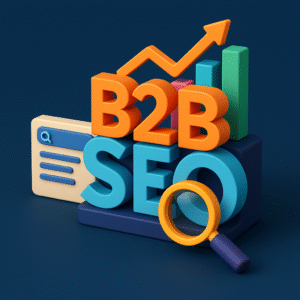

Semantic SEO
As search engines evolve, SEO has shifted from simple keyword-based strategies to more advanced techniques that focus on understanding user intent. Semantic SEO, which emphasizes the meaning behind queries and content, is at the forefront of this transformation. Instead of just optimizing for specific keywords, semantic SEO seeks to understand the relationships between concepts, offering richer search results that are more relevant to users’ queries.
Table of Contents
ToggleWhat is Semantic SEO
Semantic SEO refers to optimizing content in a way that helps search engines understand not only the literal meaning of the words but also the intent behind a search query. It focuses on context, synonyms, and related terms rather than just isolated keywords. With the rise of AI and machine learning, Google and other search engines have become more adept at understanding natural language, which means they can interpret nuances in user searches better than ever before.
In simple terms, while traditional SEO revolves around the keyword itself, semantic SEO dives deeper into the “why” behind the search. For example, someone searching for “best laptops for students” isn’t just looking for any laptops—they’re looking for devices that cater specifically to students’ needs, like portability, battery life, and budget. A semantic SEO strategy aims to anticipate and answer these deeper needs.
How Search Engines Use Semantics
Search engines use various technologies and algorithms to better understand content in a semantic context.
Two key innovations include:
1. Latent Semantic Indexing (LSI):
Latent Semantic Indexing helps search engines find relationships between words. It means search engines don’t just match exact keywords but also look for terms related to the main query, understanding how these terms fit together contextually. For example, if you search for “digital marketing,” search engines will also look for terms like “SEO,” “PPC,” and “content marketing,” which are related to the main topic.
2. Google’s Hummingbird and BERT Updates:
Google’s Hummingbird and BERT (Bidirectional Encoder Representations from Transformers) updates represent significant advancements in semantic search. Hummingbird allows Google to understand the meaning behind queries instead of simply focusing on individual keywords. BERT, on the other hand, helps Google process words in relation to all the other words in a sentence, making it easier to grasp the full context of a search.
These technologies enable search engines to deliver more accurate, relevant results by understanding the context and intent behind a search, even if the user’s query is vague or incomplete.
Why is Semantic SEO Important
1. Enhanced User Experience:
The primary goal of semantic SEO is to align content with what users are genuinely looking for. By addressing user intent and providing comprehensive answers, websites can deliver a more satisfying and intuitive experience. This leads to longer dwell times, lower bounce rates, and increased trust in your brand or content.
2. Voice Search Optimization:
With the increasing popularity of voice search through devices like Google Assistant, Alexa, and Siri, semantic SEO is more crucial than ever. Voice searches tend to be more conversational and question-based, and they often rely on semantic search technology to provide the most relevant responses. By optimizing your content for semantic search, you improve its chances of ranking well for voice queries, which are typically longer and more specific than typed searches.
3. Better Content Visibility:
Semantic SEO helps improve visibility for a broader range of queries. While traditional keyword-based SEO might only rank your content for exact keyword matches, semantic SEO ensures your content is more versatile and relevant to a wider range of related search terms. This means you can capture traffic from various angles, even if the exact keywords aren’t present.
4. Google’s Knowledge Graph and Rich Snippets:
Semantic SEO helps your content align with Google’s Knowledge Graph, which provides detailed answers to user queries in the search results. Additionally, optimizing content semantically can increase the chances of earning rich snippets or featured snippets, which appear at the top of the SERPs and provide concise, direct answers to search queries.
How to Implement Semantic SEO in Your Strategy
1. Research User Intent:
Understanding user intent is key to semantic SEO. There are generally three types of user intent:
- Informational: The user is seeking knowledge, such as “how to do keyword research.”
- Navigational: The user is looking for a specific website or page.
- Transactional: The user is ready to make a purchase or take action, such as “buy SEO tools.”
2. Use Structured Data:
Structured data, or schema markup, helps search engines understand your content better. By implementing structured data on your website, you provide additional context about your content, such as events, products, reviews, and FAQs. This can lead to enhanced search results in the form of rich snippets, which can drive higher click-through rates (CTR).
3. Optimize for Related Entities and Concepts:
Instead of focusing solely on a primary keyword, integrate related concepts and entities into your content. Use synonyms, related phrases, and variations of your main topic. For example, if you’re writing about “SEO,” you can also include terms like “on-page optimization,” “link building,” and “technical SEO.” This helps search engines understand the breadth and depth of your content.
4. Create Comprehensive Content:
Longer, more detailed content often performs better in semantic search because it covers multiple angles of a topic. When crafting content, aim to answer a wide range of questions and address all aspects of the topic at hand. This makes your content more useful and increases the likelihood of ranking for a variety of related searches.
5. Focus on Natural Language:
Since search engines are becoming better at interpreting natural language, your content should be conversational and written in a way that feels human. Avoid stuffing keywords unnaturally; instead, focus on making your content easy to read and engaging.
Measuring Success in Semantic SEO
As with any SEO strategy, measuring the success of semantic SEO requires tracking relevant metrics. Some key indicators of success include:
- Organic Traffic Growth: Over time, you should notice increased traffic from a wider variety of search queries.
- Better Rankings for Long-Tail Keywords: Since semantic SEO targets related terms and phrases, you should see improvements in rankings for long-tail queries.
- Increased Engagement: Semantic SEO helps create content that better serves user intent, so metrics like average session duration and pages per session should improve.
Conclusion
Semantic SEO is a powerful tool for modern search engine optimization. As search engines become more sophisticated, focusing on user intent, context, and meaning is essential to staying ahead of the competition. By leveraging semantic SEO techniques, you can provide more value to your audience, improve your search rankings, and ultimately drive more traffic to your website. The future of SEO lies in understanding the “why” behind a query, and semantic SEO is the key to unlocking that potential.






















Post Comment